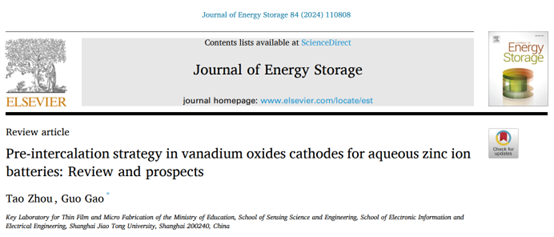- Home
- About Us
- Students
- Academics
-
Faculty
- Electrical Engineering
- Automation
- Computer Science & Engineering
- Electronic Engineering
- Instrument Science and Engineering
- Micro-Nano Electronics
- School of Software
- Academy of Information Technology and Electrical Engineering
- School of Cyber Security
- Electrical and Electronic Experimental Teaching Center
- Center for Advanced Electronic Materials and Devices
- Cooperative Medianet Innovation Center
- Alumni
-
Positions
-
Forum
News
- · Prof. Bin Dai’s team made important progress in using graphene quantum dots to regulate aberrant protein phase separation
- · Guo Gao and co-workers from Shanghai Jiao Tong University achieved significant progress on calcium-ion pre-intercalated hydrated vanadium oxide cathode to facilitate high-performance zinc storage
- · Jiamiao Yang’s team published important innovation on large dynamic range Shack-Hartmann wavefront sensor in Light: Advanced Manufacturing
- · Jiamiao Yang’s team achieved the accurate modeling of the scattering of polarized optical fields
- · Prof. Jingquan Liu’s team made new progress in nanoscale brain-computer interface devices for single neurons
Associate Researcher Guo Gao's Team from Shanghai Jiao Tong University Published a Comprehensive Review in Journal of Energy Storage: Pre-intercalation strategy in vanadium oxides cathodes for aqueous zinc ion batteries: Review and prospects
Recently, a team of researchers led by Associate Professor Gao Guo from the School of Sensing Science and Engineering, School of Electronic Information and Electrical Engineering, Shanghai Jiao Tong University, published a comprehensive review paper titled "Pre-intercalation strategy in vanadium oxides cathodes for aqueous zinc ion batteries: Review and prospects" in the internationally renowned journal "Journal of Energy Storage" in the field of energy and fuel. The paper focuses on the role of different pre-intercalation species in vanadium oxide cathode materials and the series of research advancements achieved in the development of high-performance aqueous zinc ion batteries.

Figure 1. Paper published in Journal of Energy Storage
Research Background:
Aqueous zinc ion batteries (ZIBs) have attracted widespread attention in the field of energy storage due to their inherent advantages such as high safety, low cost, and environmental friendliness. Among various cathode materials, vanadium-based materials stand out for their high specific capacity, open structure, and multivalence. However, issues such as vanadium dissolution and severe capacity decay greatly limit their further development and commercial applications. Therefore, enhancing the performance of vanadium oxide cathodes through modification strategies is of paramount importance.
In recent years, the pre-intercalation strategy of guest species has provided an effective solution to address the aforementioned challenges. This approach not only significantly enhances the structural stability of materials and accelerates charge transfer but also improves their specific capacity while achieving stable cycling.
Research Content:
The paper begins by reviewing the intrinsic properties of various novel secondary metal ion batteries and providing a detailed development history of ZIBs. Subsequently, it discusses the types, structural characteristics, and electrochemical properties of typical vanadium oxides. Addressing the existing issues with vanadium oxide materials (such as vanadium dissolution, poor electrochemical performance, structural instability, formation of by-products, slow Zn2+ migration kinetics, and strong electrostatic interactions), the research team led by Associate Professor Gao Guo further analyzes the underlying reasons why the pre-intercalation strategy of guest species aids in the development of high-performance aqueous ZIBs. They conduct a series of discussions on the pre-intercalation of species including metal ions, water molecules, and organic compounds. Finally, based on these latest research advancements, the paper proposes directions that future development of aqueous ZIBs should focus on, including cathode materials, mechanistic studies, electrolytes and zinc anodes, and commercial applications.

Figure 2. Comparison of Li, Na, K, Zn and Mg metals in terms of ionic radius, standard potential, specific capacity and theoretical volume capacity.

Figure 3. A brief history of the evolution for Zn-based batteries.
Summary and Outlook:
The paper suggests that cations, water molecules, organic molecules, and other guest species can effectively serve as "pillars" for vanadium oxide materials, stabilizing the crystal structure of the host, suppressing the dissolution of the host material, and enhancing the conductivity and reaction kinetics of the cathode, thereby achieving excellent comprehensive electrochemical performance of the battery. However, solely relying on guest pre-intercalation often falls short of achieving a significant improvement in the electrochemical performance of the cathode material. It often requires synergistic modifications through nanostructure regulation, composite conductive polymers, creation of oxygen vacancies, etc. Moreover, there are still many unresolved issues. Therefore, to avoid these problems, future research efforts should be intensified based on existing studies to achieve breakthroughs in comprehensive electrochemical performance. This can be approached from several aspects: 1. Cathode materials (suppressing vanadium dissolution, designing high voltage, high capacity, and high energy density, optimizing electrode structure, etc.); 2. Mechanism studies (using more advanced characterization techniques, combined with theoretical calculations, etc.); 3. Electrolytes and zinc anodes (such as addressing key issues like zinc dendrites, HER, corrosion, etc.); 4. Advancing commercial applications.
Currently, it has been confirmed that constructing new vanadium-based materials by pre-intercalating guest species to assist in the development of high-performance aqueous ZIBs is a promising modification strategy. However, through comprehensive analysis, further systematic and scientific research on aqueous ZIBs is still highly necessary. This is crucial for practical commercial applications and large-scale promotion.

Figure 4. Summary and outlook for aqueous ZIBs.
The first author of this paper is doctoral student Zhou Tao from the School of Electronic Information and Electrical Engineering at Shanghai Jiao Tong University, with Associate Researcher Gao Guo as the corresponding author. This research was supported by the National Natural Science Foundation of China (81671737) and the Giga Force Electronics Interdisciplinary Funding (JJHXM002208-2023).
Paper Link: https://doi.org/10.1016/j.est.2024.110808
-
Students
-
Faculty/Staff
-
Alumni
-
Vistors
-
Quick Links
